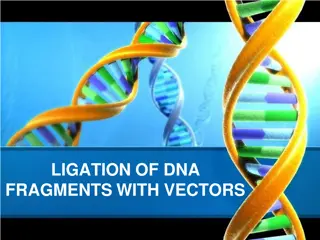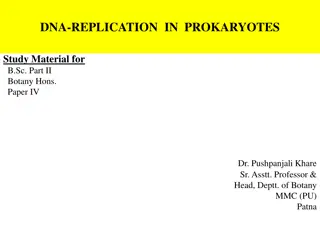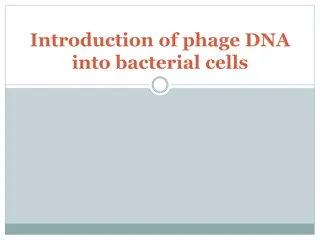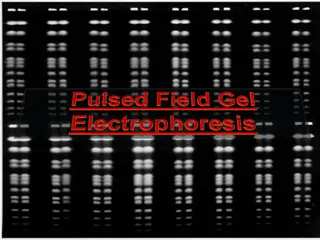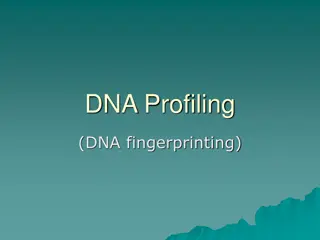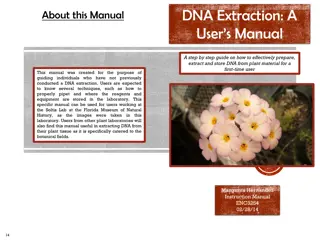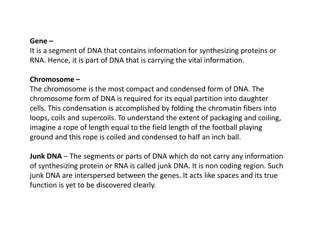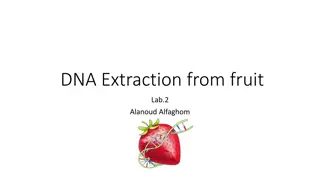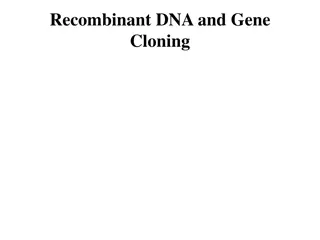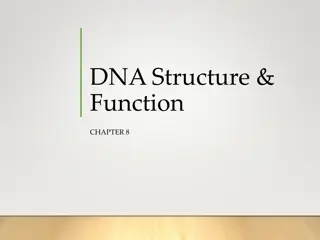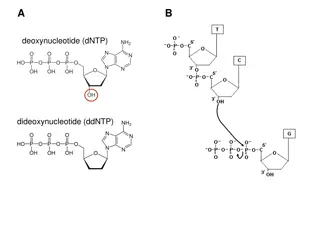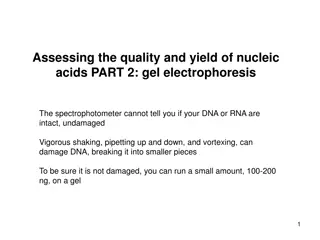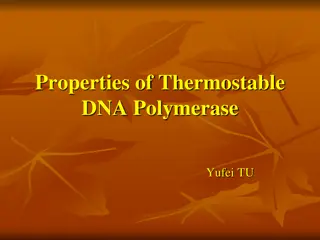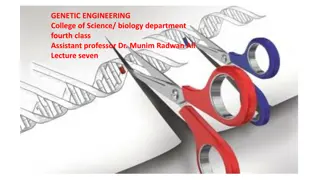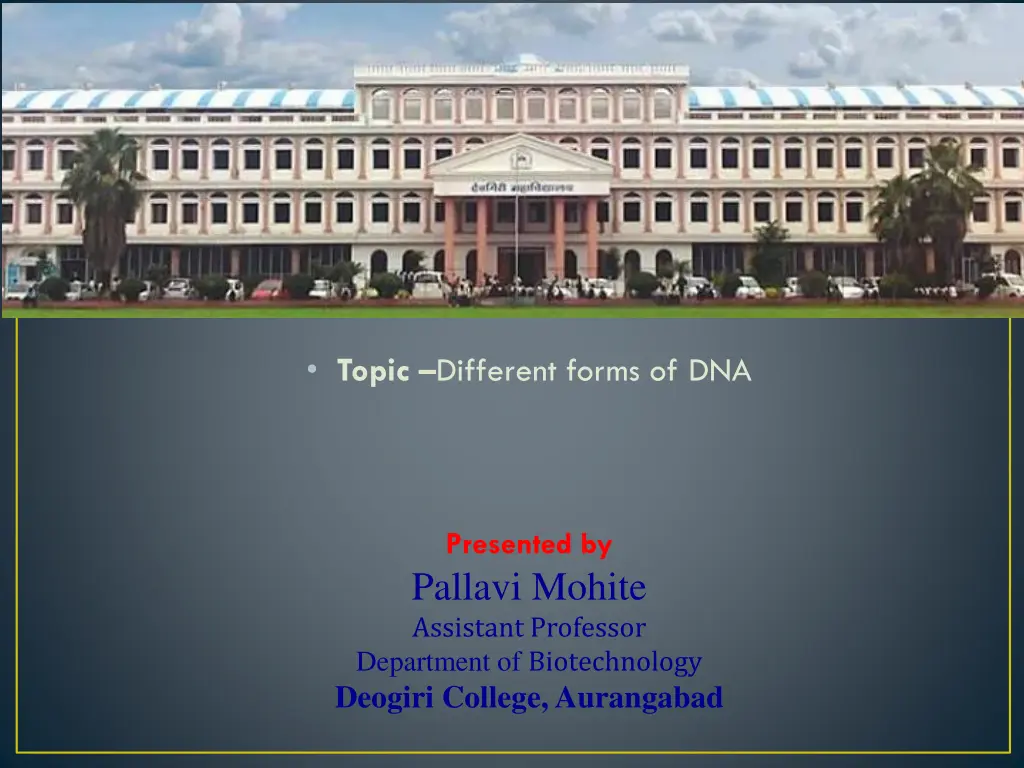
Exploring Different Forms of DNA Structures
Delve into the fascinating world of DNA structures with various forms like B-DNA and A-DNA. Understand the reasons behind the existence of diverse DNA forms and how they play a crucial role in genetic information replication. Discover the intricate details of sugar puckering, anti and syn conformations of bases, and key differences between B-form and A-form DNA structures. Unravel the complexities of DNA helices and their significance in biological processes.
Download Presentation

Please find below an Image/Link to download the presentation.
The content on the website is provided AS IS for your information and personal use only. It may not be sold, licensed, or shared on other websites without obtaining consent from the author. If you encounter any issues during the download, it is possible that the publisher has removed the file from their server.
You are allowed to download the files provided on this website for personal or commercial use, subject to the condition that they are used lawfully. All files are the property of their respective owners.
The content on the website is provided AS IS for your information and personal use only. It may not be sold, licensed, or shared on other websites without obtaining consent from the author.
E N D
Presentation Transcript
Topic Different forms of DNA Presented by Pallavi Mohite Assistant Professor Department of Biotechnology Deogiri College, Aurangabad
Different forms of DNA A form, Z form B form, Pallavi Mohite Asst. Prof. DCA
The right-handed double-helical Watson Crick Model for B- form DNA is the most commonly known DNA structure. In addition to this classic structure, several other forms of DNA have been observed. The helical structure of DNA is thus variable and depends on the sequence as well as the environment. Why do different forms of DNA exist? There is simply not enough room for the DNA to be stretched out in a perfect, linear B-DNA conformation. In nearly all cells, from simple bacteria through complex eukaryotes, the DNA must be compacted by more than a thousand fold in order even to fit inside the cell or nucleus.
Concepts to know. Sugar puckering
Anti and syn conformations of bases
B-form DNA B-DNA is the Watson Crick form of the double helix that most people are familiar with. They proposed two strands of DNA each in a right-hand helix wound around the same axis. The two strands are held together by H-bonding between the bases (in anti-conformation). The two strands of the duplex are antiparallel and plectonemically coiled. The nucleotides arrayed in a 5 to 3 orientation on one strand align with complementary nucleotides in the 3 to 5 orientation of the opposite strand. Bases fit in the double helical model if pyrimidine on one strand is always paired with purine on the other. From Chargaff s rules, the two strands will pair A with T and G with C. This pairs a keto base with an amino base, a purine with a pyrimidine. Two H-bonds can form between A and T, and three can form between G and C. These are the complementary base pairs. The base-pairing scheme immediately suggests a way to replicate and copy the genetic information. 34 nm between bp, 3.4 nm per turn, about 10 bp per turn 9 nm (about 2.0 nm or 20 Angstroms) in diameter. 34ohelix pitch; -6obase-pair tilt; 36otwist angle
A-form DNA The major difference between A-form and B-form nucleic acid is in the confirmation of the deoxyribose sugar ring. It is in the C2 endoconformation for B-form, whereas it is in the C3 endoconformation in A-form. A second major difference between A- form and B-form nucleic acid is the placement of base-pairs within the duplex. In B-form, the base-pairs are almost centered over the helical axis but in A-form, they are displaced away from the central axis and closer to the major groove. The result is a ribbon-like helix with a more open cylindrical core in A- form. Right-handed helix 11 bp per turn; 0.26 nm axial rise; 28ohelix pitch; 20obase-pair tilt 33otwist angle; 2.3nm helix diameter
Z-form DNA Z-DNA is a radically different duplex structure, with the two strands coiling in left-handed helices and a pronounced zig-zag (hence the name) pattern in the phosphodiester backbone. Z-DNA can form when the DNA is in an alternating purine- pyrimidine sequence such as GCGCGC, and indeed the G and C nucleotides are in different conformations, leading to the zig-zag pattern. The big difference is at the G nucleotide. It has the sugar in the C3 endoconformation (like A-form nucleic acid, and in contrast to B-form DNA) and the guanine base is in the synconformation. This places the guanine back over the sugar ring, in contrast to the usual anticonformation seen in A- and B-form nucleic acid. Note that having the base in the anticonformation places it in the position where it can readily form H-bonds with the complementary base on the opposite strand. The duplex in Z-DNA has to accommodate the distortion of this G nucleotide in the synconformation. The cytosine in the adjacent nucleotide of Z-DNA is in the normal C2 endo, anticonformation. Discovered by Rich, Nordheim &Wang in 1984. It has antiparallel strands as B-DNA. It is long and thin as compared to B-DNA. 12 bp per turn; 0.45 nm axial rise; 45ohelix pitch; 7obase-pair tilt -30otwist angle; 1.8 nm helix diameter
Other rare forms of DNA C-DNA Formed at 66% relative humidity and in presence of Li+ and Mg2+ ions. Right-handed with the axial rise of 3.32A per base pair 33 base pairs per turn Helical pitch 3.32A 9.33 A=30.97A . Base pair rotation=38.58 . Has a diameter of 19 A , smaller than that of A-&B- DNA. The tilt of base is 7.8 D-DNA Rare variant with 8 base pairs per helical turn These forms of DNA found in some DNA molecules devoid of guanine. The axial rise of 3.03A per base pairs The tilt of 16.7 from the axis of the helix. E- DNA Extended or eccentric DNA. E-DNA has a long helical axis rise and base perpendicular to the helical axis. Deep major groove and the shallow minor groove. E-DNA allowed to crystallize for a period time longer, the methylated sequence forms standard A-DNA. E-DNA is the intermediate in the crystallographic pathway from B-DNA to A-DNA.
DNA as a genetic material Experimental proof
Griffith called this change of non-virulent strain into virulent strain as transformation, because the virulent strain transformed the non- virulent strain into the virulent strain. This is called Griffith s transformation experiment. The phenomenon of bacterial transformation is called Griffith effect .
Identification of transforming substance: Griffith could not identify the nature of transforming substance. Oswald T. Avery, C.M. Mac Leod and M.J. Mc Carty (1944), set out experiments transforming principle. They destroyed cell constituents in extract of virulent pneumococci SIII using enzyme that hydrolyzed DNA, RNA, proteins and polysaccharides. to identify the
RII Cells + Purified SIII cell polysaccharide R colonies RII Cells + Purified SIII cell protein R colonies RII Cells -H Purified SIII cell RNA R colonies
They concluded that a cell free and highly purified RNA extract of SIII strain could bring about transformation of RII strain into SIII strain. However, this effect was lost when the extract was treated with deoxy-ribonuclease. Therefore, DNA is the genetic material and carries sufficient information for tons-formation. Thereafter, the transforming material (DNA) was also confirmed in several bacteria such as Bacillus subtilis, Haemophilus Shigella para-dysenteriae, etc. influenzae,




